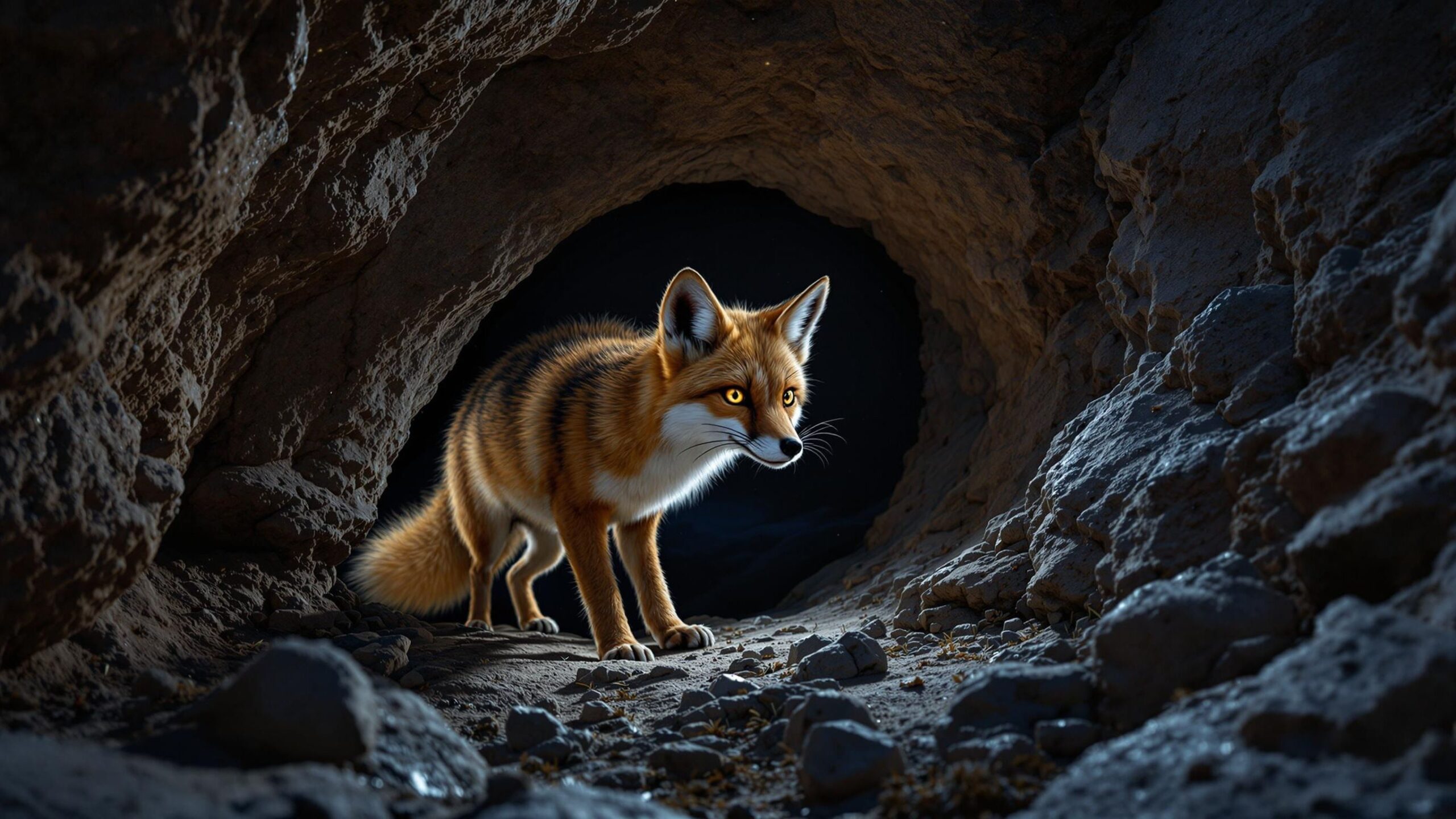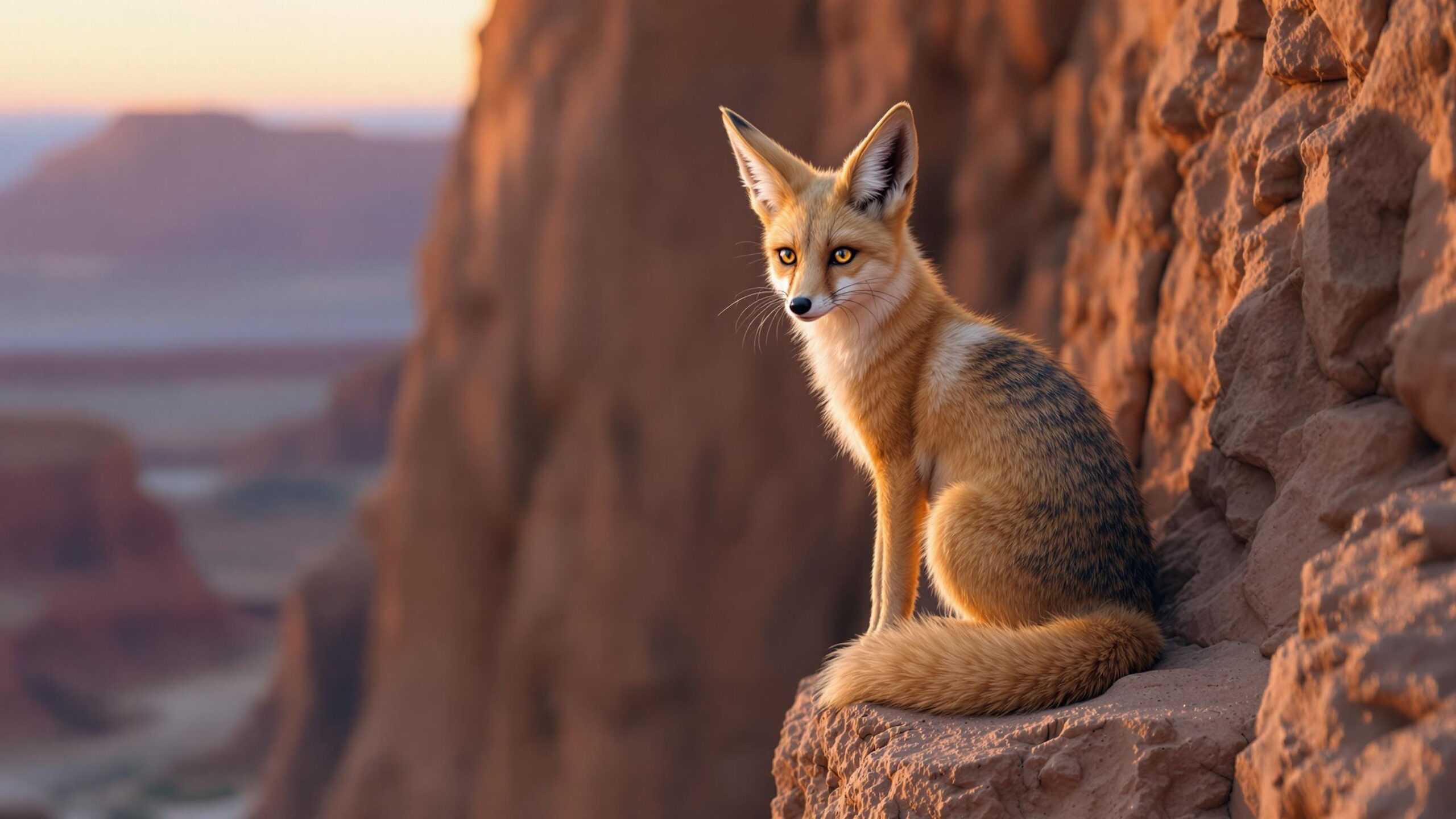Blanford’s Fox: The Desert’s Elusive Acrobat
Tucked away in some of the harshest, most sun-scorched regions of the Middle East and Central Asia lives a small, graceful, and almost ghost-like creature—Blanford’s Fox. Known scientifically as Vulpes cana, this elusive and elegant fox species is a master of evasion and balance, perfectly tailored for the unforgiving rocky deserts it calls home. Despite its wide geographic spread, Blanford’s Fox remains one of the least studied and most mysterious wild canids, moving with stealth through its secretive world of cliffs, boulders, and arid valleys.
The Fox Few Ever See
Blanford’s Fox is native to the rugged, dry landscapes of the Middle East and parts of Central and South Asia. Its range includes Israel, Jordan, Saudi Arabia, Oman, Yemen, Iran, Afghanistan, and Pakistan. Unlike the more familiar Red Fox or Fennec Fox, Blanford’s Fox keeps to the shadows, avoiding human settlements and open plains, preferring the relative isolation of mountainous, rocky terrain. Named after the 19th-century British naturalist William Thomas Blanford, this fox has evolved to live in one of the most physically challenging environments on Earth. And yet, it does so with finesse. Small, silent, and extraordinarily agile, Blanford’s Fox has largely escaped public awareness, which makes it all the more remarkable when encountered.
Appearance: A Desert Acrobat
Blanford’s Fox is immediately distinguished by its petite size and remarkably long, bushy tail—often nearly equal in length to its body. Adults typically weigh between 2 to 4 pounds and measure around 16 to 18 inches in body length, with the tail adding an additional 12 to 15 inches. This luxurious tail not only serves as a balance aid during athletic climbs but also as insulation during the cold desert nights.
Its coat is soft, thick, and generally grayish or sandy brown, ideal for blending into rocky or gravel-strewn terrain. A white underbelly and black markings on the tail tip and legs add contrast. The fox’s face is pointed, with a narrow snout, large eyes suited for nocturnal vision, and oversized ears that aid in both heat dissipation and acute hearing. Blanford’s Fox is physically adapted for agility. Its limbs are slender but strong, with sharp, curved claws that provide traction on vertical surfaces. This anatomical specialization allows it to scale cliffs and leap among rocks with astonishing ease, almost like a feline. Such nimbleness sets it apart from nearly all other fox species.
Behavior: Living in the Margins
True to its elusive reputation, Blanford’s Fox is strictly nocturnal. During the day, it retreats to caves, crevices, or burrows hidden among the rocks, emerging only under cover of night to forage. This behavior minimizes exposure to predators and the extreme daytime heat typical of its environment.
Solitary by nature, Blanford’s Fox maintains a low profile. Individuals tend to have overlapping home ranges but do not engage in territorial disputes. Instead of aggression, they rely on avoidance. Their soft footfalls and near-silent movements are perfectly suited for a life lived in quiet corners. Communication is subtle. Vocalizations are rare, and scent marking appears to play a limited role. The fox’s silence contributes to its mystique; even in regions where they are known to exist, sightings remain extremely rare. Most observations occur by chance or through camera trap footage set up by researchers.

Diet: Fruit-Loving Forager
Unlike many foxes that rely heavily on small mammals, Blanford’s Fox is predominantly insectivorous and frugivorous. Its diet includes a wide variety of insects such as beetles, grasshoppers, and locusts, as well as scorpions and small lizards. However, it has an unusual preference among foxes: fruit.
This fox is an avid consumer of dates, grapes, melons, and other locally available fruits, depending on the season and region. In places like Oman and Israel, researchers have observed foxes frequenting palm groves and orchards under cover of night, snacking on overripe fruit fallen to the ground. This fruit-heavy diet provides hydration and essential nutrients, compensating for the scarcity of freshwater sources in its arid habitat. Blanford’s Fox rarely hunts vertebrates larger than a small bird or rodent. Its preference for non-aggressive foraging—paired with its avoidance of conflict—makes it a rather peaceable creature, more likely to disappear into the rocks than stand its ground.
Reproduction and Life Cycle
Mating season for Blanford’s Fox typically begins in late winter, around January or February. Like many desert animals, their reproductive timing is synced with the arrival of warmer weather and the seasonal abundance of food. Pairs form monogamous bonds and may stay together through the breeding season or longer. After a gestation period of approximately 50 to 55 days, the female gives birth to a litter of 1 to 3 kits. The den, usually located deep within rocky crevices or small caves, provides shelter and protection from predators and environmental extremes.
Kits are born blind and helpless, relying on their mother for warmth and milk. The male often assists in bringing food to the den. Around four weeks after birth, the kits begin venturing outside and learning to forage under the watchful eye of their parents. By three to four months of age, they are typically weaned and ready to begin independent life, although they may remain near their natal den for a while before fully dispersing. Lifespan in the wild is not well-documented due to the species’ secretive nature, but it is estimated to be around five to seven years, with individuals in captivity living slightly longer.
Habitat: Masters of the Rocks
The preferred environment of Blanford’s Fox is rocky desert terrain, particularly areas with steep cliffs, canyons, and boulder-strewn hillsides. These locations provide ample hiding spots and vertical escape routes from predators. The fox’s climbing ability allows it to exploit niches in the landscape that are inaccessible to most other terrestrial animals. Elevation ranges vary by region, with some populations found at sea level and others thriving at altitudes exceeding 1,000 meters. What these habitats all share is a combination of sparse vegetation, extreme temperature fluctuations, and very limited water sources. In such challenging environments, Blanford’s Fox depends on its physical adaptations and behavioral strategies to minimize water loss, conserve energy, and stay out of harm’s way. It does not dig its own dens but rather uses natural shelters, adding to its ability to live with minimal ecological disruption.
Predators and Survival Challenges
Blanford’s Fox is not entirely without threats. Natural predators include birds of prey, such as owls and eagles, as well as wild cats and larger canids like jackals or wolves in some parts of its range. However, the fox’s small size, cryptic coloring, and nocturnal lifestyle make it a difficult target.
The greater challenge comes from environmental change and human expansion. Overgrazing by livestock can degrade its habitat, and agricultural development encroaches on its foraging grounds. Road construction, tourism, and urban sprawl further fragment the fox’s range, pushing it into increasingly isolated pockets. Nevertheless, the species demonstrates a surprising ability to persist near human-modified landscapes—as long as rocky cover remains available. In regions such as Israel and Oman, Blanford’s Fox has even been observed using dry stone walls and abandoned buildings as daytime shelters.
Conservation Status: A Subtle Concern
According to the International Union for Conservation of Nature (IUCN), Blanford’s Fox is currently listed as a species of “Least Concern.” Its broad geographic range and apparent adaptability have so far helped it avoid the high-risk categories that apply to many other desert-dwelling mammals.
However, the classification belies the fact that population data is limited. The fox’s nocturnal and secretive behavior makes it difficult to study, and most range assessments are based on sparse sightings or indirect evidence such as tracks or scat. In truth, the species may be far more vulnerable in specific locales than its global status suggests. Local conservation efforts are beginning to increase, especially in countries where biodiversity is becoming a focal point of ecotourism or environmental education. Protected areas, camera trap studies, and community outreach programs all contribute to better understanding and safeguarding the species.
Cultural Connections and Regional Lore
Although not as prominent in folklore as some other foxes, Blanford’s Fox holds a quiet place in regional cultural consciousness. In the Arabian Peninsula, its elusive nature is often admired, symbolizing cleverness and serenity. In some local dialects, it is known as the “rock fox” or “desert fox,” often confused with the Fennec due to its large ears and desert habitat. Unlike the Red Fox, which sometimes enters human folklore as a trickster or thief, Blanford’s Fox is seen more as a gentle spirit of the wilderness—present but rarely seen, a sign of wildness untouched by modernity. Its absence from mainstream media and lack of human conflict give it a uniquely peaceful reputation. In the places where it still thrives, the fox is an important indicator of ecosystem health and natural balance.
Scientific Interest and Modern Research
Only in the past few decades has Blanford’s Fox begun to attract the attention of scientists and conservationists. Field studies using camera traps and non-invasive tracking have started to shed light on its behavior, range, and ecology. Research initiatives in countries like Israel, Oman, and Iran are uncovering details that challenge long-held assumptions about the species. For example, studies have revealed that despite its solitary habits, Blanford’s Fox exhibits subtle social behaviors during mating season and may even share foraging zones with others. Its high adaptability to various rocky environments also suggests a broader potential distribution than initially recorded. Genetic analysis has confirmed its classification within the Vulpes genus, placing it in close relation to species like the Rüppell’s Fox and the Fennec. Understanding these relationships helps scientists build clearer evolutionary trees and develop targeted conservation strategies for desert foxes as a group.
A Hidden Gem of the Wild
Blanford’s Fox may never gain the celebrity status of its Red or Arctic cousins, but that seems perfectly fine for an animal that has built its entire existence around not being noticed. In a world that often rewards noise and visibility, the fox’s quiet, balanced way of life feels like a gentle reminder of the power of subtlety and adaptation. Every twist of a canyon, every silent night on a moonlit cliff, holds the possibility that one of these small desert acrobats is watching from the shadows. It is an animal of patience, purpose, and peace—one that lives not by dominating its environment, but by harmonizing with it.
Conclusion: Nature’s Nimble Nomad
Blanford’s Fox, Vulpes cana, is more than a rare desert dweller—it is a symbol of survival through subtlety. Living quietly among rocks and shadows, it represents a form of wilderness that is easily overlooked but deeply vital. Its story is one of refined balance: between visibility and concealment, energy and economy, solitude and sustainability. As human footprints continue to expand into the world’s drylands, preserving creatures like Blanford’s Fox becomes not only a matter of protecting biodiversity but of honoring a quieter way of life that has endured for millennia. In its silence lies resilience, and in its solitude, a kind of wild wisdom we would do well to understand and respect.

